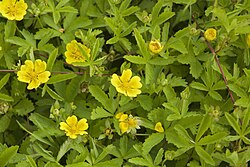Native Range
Potentilla reptans has a large native distribution across the continents of Europe, Asia, and Africa. In Europe it can be found in the countries of: Albania, Austria, Belarus, Belgium, Bulgaria, Corsica, Czech Republic, Denmark, Finland, France, Germany, Great Britain, Greece, Hungary, Ireland, Italy, the Netherlands, Poland, Portugal, Romania, Slovakia, Spain, Sweden, Switzerland, Turkey and Ukraine. [5] In Asia it can be found in: Afghanistan, China, Cyprus, Mongolia, Iran, Iraq, Kazakhstan, Kirgizstan, Lebanon, Syria, Pakistan, Israel, Palestine, Tajikistan, Turkmenistan and Uzbekistan. [5] In Africa it can be found in the countries of: Algeria, Eritrea, Ethiopia, Libya, Morocco and Tunisia. [5]
Introduced Range
P. reptans has been introduced outside its native range into various countries across the globe. [6] The species has been widely distributed across North America, where it can be found in the states and territories of: Bermuda, California, Colorado, Florida, Georgia, Illinois, Kentucky, Louisiana, Maryland, Massachusetts, Michigan, Minnesota, New Jersey, New York, Ohio, Oregon, Pennsylvania, Virginia, Washington and Wisconsin. [5] It has also been introduced in Canada in the provinces of Ontario, Québec and Nova Scotia. [5] In Oceania the species was also introduced into the countries of Australia and New Zealand. [5]
